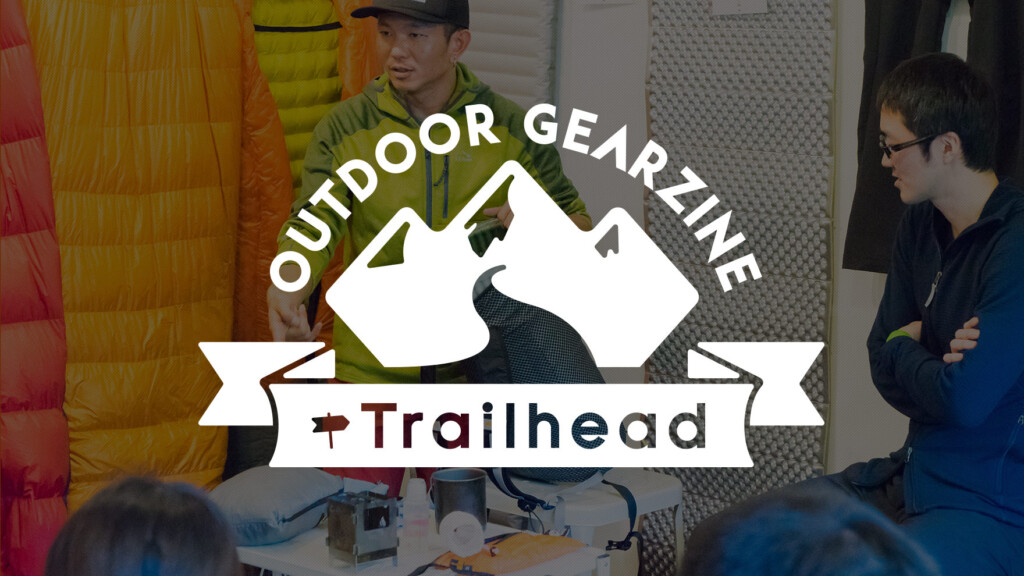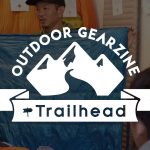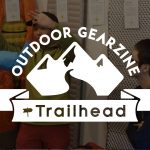
What does UL packing look like for masters? 01 What is the contents of Arai Yusuke's carefully selected backpack?
"Outdoor Gearzine Trailhead Presents Arai Yusuke Packing Course 2016" was held on a very popular day in November last year, and was hosted by this website. When I asked Arai to be the instructor, he asked me to give him a relaxed request, "Please give me a story that would be interesting for beginners who are just not good at packing!", and when I opened the question, I spent over two hours of machine gun talk in both the first and second parts. The event was packed not only to packing, but also packed with great techniques and tricks that only a master can offer, from recommended equipment to truly useful mountain climbing skills.
What is Outdoor Gearzine Trailhead?
Outdoor Gearzine was held in November 2016 at a gallery near Yoyogi Park for two weeks under the theme of "Starting autumn mountain climbing with Outdoor Gearzine . There is an exhibition of recommended autumn mountain tools, a corner for purchasing tools, a store for valuable outdoor gear, a flea market for used mountain tools after the test, and a talk event with mountain photographer Arai Yusuke, and various projects are being held that can be enjoyed by people who want to climb the mountains or have recently started climbing the mountains. This event has been a huge hit with readers of this site and mountain enthusiasts who have come here casually. For more detailed plans, please see this past announcement page .
I was reporting on the plans to release the talk in a video, but it took me unexpectedly longer to organize the topics that were spurting on the occasional momentum that is typical of live shows. We've finally opened a YouTube channel.
Now that we have finally come together, we will finally be sharing the events with explanations, divided into several themes. Just to be careful, please be aware of this in advance, but the topics introduced here include things that can only be practiced by people who are based on experience and physical strength, and not all of them can be imitated unconditionally by everyone. With that in mind, these are all very useful and interesting stories, so please be sure to consider this carefully before using this as a reference!
Profile of Arai Yusuke
Mountain photographer. Head of SHARA PROJECT. Since his father's acquaintance was a traitor, he grew up in a deep, intimate nature from a young age. He has a deep knowledge of a wide range of fields, from traditional trekking to UL hiking, skiing, MTB, hunting and survival techniques, and outdoor gear, and is also well-versed in knives. Every year in autumn and winter, it is a bush crafter that clings to hunt, and then dismantles and cooks in the mountains.
table of contents
table of contents
- Packing techniques for ultra light hiking - What is the contents of the backpack that was stripped down by experience and calculations? ~ (Video)
- Video and audio transcription
- Video commentary
Packing techniques for ultra light hiking - What is the contents of the backpack that was stripped down by experience and calculations? ~
First half of the talk, we first showed us what Arai had in her recent backpack. By the way, in the video, the one on the left is Arai, and the listener on the right is me (Hisatomi).
Video and audio transcript
Arai Yusuke : I usually work as a mountain photographer. I also had a very biased start to become a mountain photographer, and while taking posters, catalogs and promotional photos, I began taking photos of extreme sports. So I went in the outdoors*1. But now I have a lot of photos from magazines, but I was taking a photo shoot at Yosemite before and then slipped 20 meters. It was a time when my family was growing, so a family meeting was held and I was like, "How many times do you fall in a year?" So I moved to magazines.
I used two SLR camera equipment, three large medium format cameras, and six lenses, and bringing tripods, batteries, etc., and the total weight would generally exceed 60 kg, so (inevitably my luggage) went in the direction of Ultra Light. However, the Ultra Light has also become too extreme, and for a while I've been able to reach a sub-ultra light under the Ultra Light, which has been left out of clothes, food, water, and fuel, but the weight (base weight) is less than 4.5 kg. That's what it was like to go too far, and now I'm settling on Ultra Light.
For four days to a week, it's probably about that much when everyone enters the mountains (pointing to the 40L pack on the wall). Ah, not enough? So, there was a little more, but for me, I usually get 20 liters of GOLITE for a week. There are currently two shelters in it and the lids don't close. Normally (with towels, small items, and thin strips) is rain gear, so this is the first tent. Then there was a cup, a second tent, down (jacket), a sleeping bag, and a change of clothes. This will fill up with food and water, and that's about it . This is what it looks like when you remove the mat (crumpled the backpack). It doesn't contain any frames, so it's a matte instead of a frame. By the way, this is the only sleeping mat (upper body).
Hisatomi : Did you cut it (by yourself)?
Arai Yusuke : Yes, I cut it off. It was originally twice as long. When I go to sleep, I only use this (the upper body). It's enough for the lower body to be different from the heel to the knee.
Hisatomi : (Hiking in places where there is no snow) is like that all year round?
Arai Yusuke : Yes, it's over the course of a year. I'm currently playing a game called "bushcraft," and during the winter I carry a shotgun and use it as a substitute for rice while hunting deer and bears . You might think it's light if you don't have food, but first of all, a gun weighs about 5 kg. Furthermore, if I had caught my prey, I could have got it, and no matter how much I handled it with a 100kg bear, it would have been around 35kg. He says he has to carry that on his back. It's not ultra light at all, but lol.
So I'll put it over here (the first of the two tents). The other is a poncho type tent. It's something that looks like a cape. If this is the case, you don't need rain gear (you can remove rain gear sideways). That's all. All my gear is about a week.
Hisatomi : I think there are some people who say that they don't have a water bottle.
Arai Yusuke : This water bottle (a plastic bottle) would be fine. The rest is hydration. It's the one that pulls the hose. the changes I have here are wool shirts, wool tights, and a fleece jacket. I only change clothes once a week. The reason is that wool is a material that is less likely to increase bacteria, so it does not smell (hygienic). Also, it's comfortable because it won't get cold even when wet. If you layer that material, you can somehow manage. If you think it's better to dry quickly, synthetic fibers are better. However, if it dries quickly, it means that it cools down, and the evaporation heat will be taken away from your body temperature. In that case , by adding synthetic fleece to the middle layer (wearing wool on the base), layering the moisture from this (wool) so that the fleece (fleece) releases moisture . It's no use for things to wear on top to have a slight smell, but I think the most common items are worn underneath, what you wear while you're doing, and T-shirts from spring to autumn, but wool is recommended.
However, there is a disadvantage to wool. (When you stretch the fabric), your hands are faintly visible, but soon a hole will appear. If you carry something heavy on your back, the shoulders will become thinner. That's the only problem. The rest is more expensive than synthetic fibers.
*1 As his father's acquaintance was a matagi, he naturally learned Matagi-style survival techniques from his elementary school age. This is the only way to move to outdoor work.
Video commentary
I'm sure you all felt it right away, but as you listened to it, you could see a crazy smell wafting out from the beginning. When it comes to outdoor extreme sports, there are only just entrances, where free climbing is a sport that can only be done without entertainment, such as speed climbing of ice walls, which is extremely high and difficult, and bass jumping in a wing suit like a flying squirrel, jumping from high ground. If it's a job where you carry a heavy camera and take a photograph, it's safe to assume that it's impossible unless you have the same physical abilities and skills as an athlete. Furthermore, the scale of Arai's talk, which is also a hunting professional, is clearly different from that of us ordinary people. First of all, keep in mind that this is the case for such people.
List of contents of Arai's backpack
Here's a summary of what Arai packs during her weekly snowless season (mainly autumn) and tent hiking.
*We are currently checking detailed items, so there may be some minor adjustments to make in the future.
I have included product links to the extent I know about each item, but there are many clear reasons and helpful stories about each of these. Also, from what I've heard about the talk, it's quite unlikely that they're using commercially available products as they are, and they seem to have been modified in some places, so I'll introduce them to the extent that they're available in individual topics that will be released in the future.
- Backpack (GOLITE Ion 20L, discontinued)
- Sleeping pad (Can frame, Thermalest ridge rest Sawlight )
- Sleeping bag (Can Down Pants, Montbell Down Multi Blanket #5 )
- Shelter (Cum poncho, Six Moon Designs Gatewood Cape )
- Stove (Alcohol, solid fuel, firewood, windshield, Bushcraft Essentials Bushbox )
- Cooker (Cum mug, snow peak titanium single mug 600 )
- Water bottle or hydration
- Cold protection down jacket (water-repellent down, packable type)
- Changing clothes (wool shirts, tights, fleece)
- Towel (packed towel)
- Headlamp
- Accessories (slim 2mm x 30m, hammock ring, thud knife, lighter, cutlery, toilet paper, etc.)
- Behavioral diet (nuts and gel)
This contains the clothes, water, food, and fuel (alcohol and solid fuel) that you can go on a hike for just 5-6 nights. In my personal experience, 2 or 5 nights aren't that different, but no matter how you look at it, it's impossible to get 20L in a solo tent lol. Even if it's more than double the capacity, it's not surprising.
Of course, the ways of enjoying it and thinking vary widely, and everyone is different, so this style is not a great one, and there is no way it can be done even if you want to copy it, but it is always stimulating to learn about the life experiences of those who have gone all the way and the philosophy behind it.
"Dual use" is not only UL, but also the first step towards becoming a beginner in packing
I think Arai's gearlist is incredibly impressive in three ways.
One of the reasons is all equipment is simple and lightweight, and is consistent . Although this is a part that people like me cannot understand at all, "we can't hold back on tools that are just light and not comfortable," it is not just a matter of principle, but it cannot be denied that it is only possible to have physical strength and perseverance that will not be shaken by a slight discomfort. In that sense, there is no doubt that physical strength and experience are essential to mastering UL.
Another thing is that we are boldly stripping away tools that can be eliminated by acquiring knowledge and skills, as well as tools that can be eliminated . By being familiar with the shelter's setup methods and weaknesses, you can only have Zelt tents, and in many cases you do not bring sleeping bag covers with you, and you also work in mountain rescue operations, and have a wealth of knowledge about emergency medical care, so you can keep emergency medical care to a minimum. In another part of the talk, Arai also says, "I will not take things I haven't used three times," and as I enter the mountains many times, I will be able to increase the number of drawers in various cases, making it even more refined to decide which tools I will use and not use on my upcoming trip, and I will be able to carefully select them as the minimum necessary tools.
The ending was quite helpful to me personally, but there are many ideas to "put together the tools that can be used as well . As a basic rule, I chose a frame and mattress, which also serves as a shelter and rain gear, and a stove that can be used in a variety of ways and can be used as a windshield. There is one towel. The quilt-shaped down sleeping bag can also be used as down pants. It has ultra-long thin pulls and tape slings that can be used as a shelter rope, spare shoelaces, and emergency triangle slings. There are many places where you can simply put together all the complicated tools with just a little ingenuity. When I think about it, it's a small detail, but if I try to work hard to act like a towel while I'm on the move, a public bath towel after descending the mountain, a change of clothes and cold weather gear, emergency sheets and zelts, I still have many things I can do.
That's what I've seen in Arai's backpack during his weekly hike.
The talk is still in the beginning. Next time, we will be introducing topics that have been expanding in the list above, so please look forward to it!


 What does UL packing look like for masters? 05 Tips for good packing and how to choose a smart backpack
What does UL packing look like for masters? 05 Tips for good packing and how to choose a smart backpack What does UL packing look like for masters? 03 How to use sleep bags and sleeping pads
What does UL packing look like for masters? 03 How to use sleep bags and sleeping pads What does UL packing look like for masters? 02 The secret to packing is how you use the stuff sack.
What does UL packing look like for masters? 02 The secret to packing is how you use the stuff sack. What does UL packing look like for masters? 04 Tips for choosing shoes and how to tie shoelaces that don't easily loosen
What does UL packing look like for masters? 04 Tips for choosing shoes and how to tie shoelaces that don't easily loosen